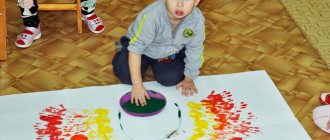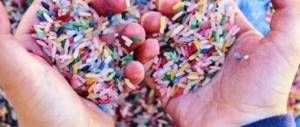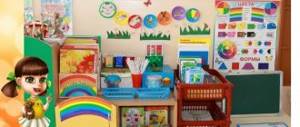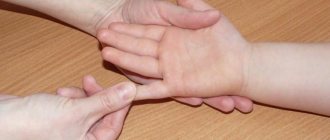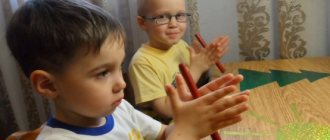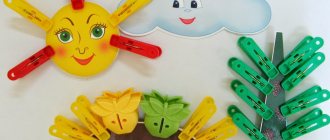The influence of fine motor skills on the speech development of preschool children. article on speech development on the topic
The influence of fine motor skills on the speech development of preschool children
“The origins of children’s abilities and gifts
are at your fingertips..."
V.A. Sukhomlinsky
Speech is of great importance in life. Speech development is becoming increasingly important in our society. Speech is one of the most powerful factors and stimuli in a child’s development.
In recent years, there has been a trend in our country towards an increase in the number of children with speech development disorders. These deviations are associated primarily with unfavorable environmental conditions and various infections. The problem of speech correction is relevant in our time. Considering that speech deviations occur at an early age, they need to be identified and corrected in a timely manner.
Scientists have proven that in the last 10 years the level of speech development of children has noticeably decreased. In our time, there has been a declining level of everyday culture: low-quality literature, “poor speech from TV screens” have become widespread, parents talk less with their children, citing a lack of free time. The child mainly receives the information he needs from television and radio programs. All this does not contribute, and, of course, hinders the development of correct speech in children. A child’s speech, as we know, cannot be formed in isolation; its development occurs in conjunction with general development, physical and mental.
Speech is, first of all, a tool of communication. The development of speech in a child is associated with the formation of the personality as a whole, the development of basic mental processes. The clarity and accuracy of thinking depends on the wealth of vocabulary and the ability to choose the best and most accurate word. If the speech of a preschooler is insufficiently developed, and even more so if there are any problems, even if not clearly expressed, difficulties arise at school age with mastering the processes of reading and writing.
If we turn to the historical aspect of the development of speech in society, we will establish that in the beginning there were gestures as a means of communication. Later they began to be accompanied by shouts and exclamations. And it took thousands of years before verbal speech appeared and then developed, such as we know it now. But for a long time speech continued to be combined with gestures. Hand movements continued to improve, leading to the development of speech.
The development of a child’s speech is approximately the same. First, the movements of the fingers develop, then the articulation of syllables appears; all subsequent improvement of speech reactions is directly dependent on the degree of training of finger movements.
Nowadays, you can notice a significant pattern - “fingers help you speak.” This is not just a well-known expression. Often a person who cannot find the necessary words finds it difficult to explain and helps himself with gestures. At the same time, a child, enthusiastically drawing and writing, helps himself by involuntarily sticking out his tongue.
Researchers from different countries have established, and practice has confirmed, that the level of speech development is directly dependent on the degree of formation of fine movements of the fingers. It turns out that if you carefully look at the image of the brain, it becomes clear that the speech area is located next to the motor area, being part of it. 1/3 of the entire area of the motor projection is occupied by the projection of the hand, located close to the speech zone.
Therefore, training the movements of the fingers and hands is the most important factor stimulating the child’s speech development, helping to improve articulatory movements, preparing the hand for writing and, no less important, a powerful tool that increases the performance of the cerebral cortex, stimulating the development of the child’s thinking.
A child with a high level of development of fine motor skills is able to think logically, his memory, attention and coherent speech are sufficiently developed.
Many scientists have studied the relationship between fine motor skills of the hands and the level of speech development. Eastern doctors have found that massaging the thumb increases the functional activity of the brain. Research by Russian physiologists confirms the connection between hand development and brain development. The works of V. M. Bekhterev proved the influence of hand manipulations on the speech functions of higher nervous activity. Simple hand movements help remove tension not only from the hands themselves, but also from the lips, and relieve mental fatigue. They help improve the pronunciation of many sounds, and therefore the development of speech. The famous researcher of children's speech, Mira Mikhailovna Koltsova, noted that the hand should be considered as a speech organ. If the movements of the fingers correspond to age, then speech development is within normal limits.
Maria Montessori noticed a connection between the development of fine hand movements and children's speech. She concluded that if speech was not normal, fine motor skills were probably to blame. Famous teacher V.A. Sukhomlinsky said: “The mind of a child is at the tips of his fingers,” “The hand is the instrument of all instruments,” Aristotle concluded. “The hand is a kind of external brain,” Kant wrote.
The development of motor skills leads to the development of speech. Fine motor skills of the hands are various movements of the fingers and palms. Work on the development of fine motor skills will improve and accelerate not only the development of fine motor skills of the hands, but also the speech development of children of early preschool age, improve the quality of speech, clarity of sounds and expand their vocabulary, and will arouse children’s interest in learning new and interesting things. Therefore, training the movements of the fingers and the entire hand is the most important factor stimulating the child’s speech development.
In modern society, children rarely do anything with their own hands, because modern toys and things are designed as conveniently as possible, but are not effective for the development of motor skills (clothes and shoes with Velcro instead of laces and buttons, books and manuals with stickers instead of pictures for cutting out, etc. .d.). Remember, now even in kindergartens they ask you to bring shoes with Velcro, so that teachers do not have to take the trouble to teach the child to tie his shoelaces. Even 20 years ago, parents, and with them their children, had to do more with their hands: sort through cereals, wash clothes, knit, embroider.
The consequence of poor development of general motor skills and, in particular, the hand is the general unpreparedness of most modern children for writing or problems with speech development. Children with poorly developed motor skills do not skillfully hold a spoon or pencil; they cannot fasten buttons or lace their shoes. It can be difficult for them to collect scattered parts of construction sets, puzzles, counting sticks, and mosaics. They often refuse to sculpt and appliqué and do not keep up with their peers in the group during activities.
Unfortunately, most parents learn about problems with coordination of movements and fine motor skills only before school. This results in an increased burden on the child: in addition to learning new information, he also has to learn to hold a pencil in his unruly fingers.
Finger training, that is, the development of fine motor skills, should begin as early as possible, especially in children with general speech underdevelopment.
Fine motor skills of the hands are developed by: finger gymnastics; exercises with a massage ball; finger theater; games with construction sets, mosaics, puzzles; plasticineography; reel games; games with counting sticks; nitcography; cutting simulator; drawing with fingers, palm; games with household items:
*with pasta, with cereals
*with clothespins
*with elastic bands, beads, hairpins;
Exercises using paper, paper napkins, cotton wool; playing with sand and water.
When working on the development of fine motor skills, you must follow certain rules:
1. Exercises should be carried out regularly, in accordance with the individual characteristics of the child, age, and capabilities.
2. The exercise that is offered to the child must be prepared in advance by the teacher (the movements are rehearsed, the text is memorized).
3. You need to start with easier exercises, and as you master them, introduce more complex ones.
4. Alternate between new and old games and exercises.
5. Carefully ensure that the child performs the exercises correctly.
6. Tasks are performed at a slow pace, first with one hand, then with the other, and finally with both hands together.
7. Instructions should be calm, friendly, and precise.
8. Perform certain movements while listening to (and then reciting by the child) the poem.
9. Conduct classes emotionally, actively, to reinforce the child’s interest.
10. Don’t forget to praise your child for his successes!
So, if the fingers develop, the child’s speech and thinking will develop, and the problems of not only learning many types of activities in kindergarten, but also later in school will disappear.
How to properly perform finger exercises up to 3 years old
Finger exercises for speech development at 1.5-3 years old can be accompanied by the display of pictures. First you can show a bright colorful image, show it, and then do the exercise. Over time, the baby will learn the material and remember what to do. The gymnastics is completed with a light massage and stroking of the fingers and arms.
Warming up your fingers before the main exercises and games
In order for finger games for speech development to bring maximum benefit, proper preparation for them is important. It’s not difficult at all – just warm up your palms by rubbing them together. If the baby finds it difficult to do this himself, the mother should help him.
In addition to this, you can gently stroke your fingers from the pads to the palm and vice versa. It will not be superfluous to gently rub your hands from hand to elbow and back. All influences are performed very carefully and carefully so as not to cause a negative reaction from the child.
Clap games
These games are a variation of the game “okay”. They develop fine motor skills, a sense of rhythm, attention, and muscle memory. The poetic texts accompanying the claps can be chanted or recited. You can clap in your own hands, in your partner’s hands, on the body, on the table.
- "Vegetable Garden" .
Children clap their hands or their parents' hands.
-We have a vegetable garden and grow dill, tomatoes and lettuce on it.. Our vegetable garden is just a treasure! There is parsley and beans, Cucumbers, radishes, carrots, Zucchini and squash, Beets, radishes, green onions, And, of course, zucchini, And watermelon, and even melons. Have you planted everything you can? (spread your arms to the sides) We didn’t miss anything.
- "Dance with a cat" .
Accompanied by rhythmic clapping.
The cat was getting married, she invited us to the wedding, we will dance with her to please the guests.
- "Doves"
- The doves flew to the green meadows (we wave our wings), They drank, they ate, They sat near the shore (we clap our hands), They got drunk in the cold, They rushed along the river, Shu! (we flap our wings).
Educational poems for finger games
If the poems accompanying finger gymnastics are meaningful and interesting, the benefit of such a correction doubles.
- Kittens
All the kittens washed their paws: That's it! Like this! (imitation of washing), We washed our ears, we washed our bellies: That’s it! Like this! And then they got tired: That's it! Like this! They fell asleep sweetly: That's it! Like this! (sleep simulation)
- Small birds
Little birds, Small birds. They fly through the forest, sing songs (we wave our arms like wings), a violent wind has blown (hands up), they wanted to carry away the birds. The birds hid in the hollow (covered their heads with their hands). It was cozy and warm there.
- Two arms
Look, here are two hands: right and left! (show hands) They can clap their hands - both right and left! (clap), They can pinch my nose - both the right and the left! (press) Both the right and the left can cover their mouth with their palm! I am always friends with my hands – both my right and my left! (handshake) And both the right and the left can be affectionate! They will hug you, they will press you to me - both the right and the left! (hug ourselves)
Games that develop creativity and speech
Such finger games for early preschoolers are necessarily accompanied by the display of pictures or toys or objects. In children aged 1.5-3 years, visual-figurative thinking predominates, so they learn the material better.
Creative speech games are good because they solve several problems at the same time. Such games have a positive effect on fine motor skills of the hands, develop memory and attention, and stimulate speech development.
- "Fairy tales"
- Let's count our fingers, Let's name fairy tales (play with our fingers). This fairy tale “Teremok”, This fairy tale “Kolobok”, This fairy tale “Turnip” About a granddaughter, grandmother, grandfather (we touch the other fingers with our thumb). “The Wolf and the Seven Little Goats” - Everyone is happy about these fairy tales!
- «
Pets" While reading the text, alternately show the fingers on one and the other hand.
The cow is happy with her calves, the sheep is happy with her lambs, the cat is happy with her kittens, who is the pig happy with? Piglets! The goat is happy with her kids, and I’m happy with my kids! Oh, a mosquito is flying here! Hide your hands! (put it behind the back)
- "Snowball"
One, two, three, four, (we bend our fingers), You and I made a snowball (sculpt), Round, strong, very smooth (we imitate stroking the ball), One – we’ll throw it, Two – we’ll catch it, Three – we’ll drop it And... we’ll break it! (stomp our feet)
After the games have been mastered, you can try to give the kids independence and invite them to show themselves what is said in the poetic text.
Drawing
While drawing, a preschooler uses muscle, visual, and tactile analyzers. Memory, attention, the ability to analyze are additional advantages obtained during this creative process in addition to the development of fine motor skills.
At the age of 1.5-3 years, it is better to use finger paints and large sheets of paper. You can take whatman paper, the remains of wallpaper. It is advisable to use no more than 2-4 colors, it is better to start with red and yellow. In this case, water is not used.
Drawing should be done as long as the child has the desire. The duration of classes is from 1-2 to 15-20 minutes. The lesson time increases gradually.
Modeling
This is one of the favorite activities of kids, which perfectly develops the sensitivity of nerve receptors on the fingertips. Coordination of hand and finger movements, new tactile sensations have a positive effect on speech development. To begin with, it is best to use the plasticine technique, since young children love to smear plasticine on any surface.
To do this, draw a simple silhouette (house, tree, beetle, cup, sun) on cardboard or a thick sheet of paper and show the child how to fill the outline with plasticine. The explanation can be accompanied by a finger game or a nursery rhyme.
Application of pasta, leaves, cereals
Manipulations with cereals and pasta are very useful for developing fine motor skills of the hands. Handling the cereal with your fingers and pinching movements have a positive effect on sensory development. In addition, they develop attention, creativity, attention.
An important rule is that you should always follow safety precautions and ensure that your baby uses the cereal for its intended purpose.
The simplest application is to sprinkle semolina or millet on a silhouette of a simple shape, previously coated with glue. The excess is shaken off and patterns or images of familiar objects magically appear on a sheet of paper.
The “pasta” applique is performed in the same way, only these products are laid out along the contour manually. Stars, spirals, waves and shells, bows and spaghetti can be painted with gouache or food coloring.
Dried leaves and flowers are an excellent material for non-traditional appliqué. These fragile components require careful handling, which forces the child to more accurately coordinate the movements of his hands and fingers. The leaves are laid out on a contour image of a simple object or in the form of a symmetrical pattern.
Natural exercises for fingers - fastening buttons, making figures from dough
The abundance of zippers and Velcro fasteners on children's clothing has deprived children of the opportunity to naturally develop finger dexterity. To compensate for this, you can make your own finger trainer. It is a set of buttons and matching loop fasteners.
You can play around with this simulator by making it in the form of a funny little animal, a sun with attached rays, or a turtle with a removable shell. It is advisable that the loops are not too tight and the buttons are not too small. For a successful training, it is important to create the right motivation: help the bunny button his jacket, otherwise he will freeze.
Modeling from salt dough is another means of developing fine movements of the hand and fingers of a young child. Massage of the fingers, which accompanies modeling from a soft and light material, has a positive effect on the baby’s sensory development and speech development.
It is impossible to taste this dough as it is salty. Crafts made together with mom can be painted, dried in a slightly heated oven and played with for a long time.
Fine motor skills test by M. A. Povalyaeva
The purpose of the test, proposed by the candidate of pedagogical sciences M. A. Povalyaeva, is to determine the norm and pathology of the activity of certain parts of the cerebral cortex. It is so simple that parents can easily do it at home.
To carry it out, you need to sit opposite the baby and cover one of his hands with your hand so that he does not see it. Then mom or dad touches the fingers of the “hidden” hand in a free manner. At this time, at the request of the parents, the baby unclenches the same finger of the other hand, clenched into a fist.
Well-being parameters – what children should determine at different ages:
- 3 years – thumb;
- 5 years – thumb and little finger;
- 6 years – index finger, thumb, little finger.
Children with parents or teachers who regularly engage in finger play and sensory development will pass this test without difficulty.
Developing fingers with preschoolers
Finger gymnastics for preschoolers can be even more complex. Children after 3 years of age are able to remember, repeat after adults, pronounce certain words or even entire poems, perform more complex sequential manipulations with their fingers, and fantasize. Therefore, the card index of such games can include a variety of nursery rhymes, story-based finger games, in which you need to play out certain actions with your fingers, imagining them as animals, wings, or legs. In such activities it is useful to use musical accompaniment.
Lessons on fine motor skills for preschool children must be structured in the form of an exciting game, so that the child participates in them with pleasure and does not think that this is a mandatory and difficult lesson.
So, the older the child, the more complex and varied hand motor skills exercises can be.
- At 3–4 years old, children can draw plot pictures, sculpt certain objects (and not just crush plasticine), assemble fairly complex models from construction sets, and build towers and houses from cubes. “Touching” exercises are useful for the development of tactile sensations (you can, for example, “introduce” the same fingers of a baby and an adult by pressing them together in turn, or involve objects of different textures in games: fur, stone, wood, silk, feathers, metal) .Now it is useful to master the lacing technique. To do this, you can purchase or make yourself special picture guides with holes through which the lace will be threaded. By competing with their child, parents will add excitement and fun to the game. Who will be the first to “lace” the waves, Christmas trees, ladders? Fastening snaps and buttons can also be practiced in a competitive manner. Another great way to use your fingers is to paint with finger paints. This is where there is room for creativity and honing small movements!
- At the age of 4–5, in addition to the above exercises, children are able to string large beads on a thread, lay out designs from buttons, pebbles, and build castles or sand pies. A big role in preparing the hand for writing is played by shading, tracing drawings along the contour, coloring, cutting out parts, and laying out mosaic applications from torn paper. Now the child can already draw not only straight lines, but also broken lines, curls, waves, and even a full person. You can complicate the task: let him draw a picture using only geometric shapes. By performing finger gymnastics, a child can already repeat the entire plot of the game after an adult: both by pronouncing it and showing it in motion.
- 5–6 years old – age on the threshold of school. Now, with the help of hand motor skills, it is necessary not only to influence the speech areas of the brain, but also to simultaneously prepare the hand for written loads: not just to hold a pen or pencil, but also to be able to write for quite a long time. It is useful, for example, to trace lines, drawings and figures in children's copybooks, to assemble a mosaic from the smallest details according to the instructions. At this age, children perceive “finger puppet theater” very well. Finger puppets are not at all difficult to make, and the performances that can be shown with their help will delight not only the child, but the whole family. In addition, ordinary finger games can be complicated. For example, do not show anything to the child, but ask him to play out a specific plot. Or use games that involve self-massage of the hands (rubbing, kneading, patting). It is also very useful now to sew on buttons, string small beads, and fold origami figures. At this stage, the connection of motor skills not only with speech, but also with coordination, logic, and memory is increasingly important.
But the main thing that parents should remember is that we develop children’s speech not only with the help of fine motor skills. On the contrary, this is just one of the means that helps stimulate or correct the baby’s speech.
However, a child - even if he has the most dexterous fingers in the world - will never learn to speak if there is little communication with him, if he is not encouraged to dialogue, retell, describe, and express his impressions. In addition, motor skills classes are often included in complexes for correcting speech skills in children with retardation. That is, they are used together with articulation exercises, logorhythmics, classes with a defectologist, psychologist, and drug treatment. Therefore, you cannot place your hopes only on the small muscles of the arms. But we can’t do without them either. As already mentioned, they contribute to the activation of many thought and mental processes, including speech.
In addition, if a child knows how to use paints, scissors, strings, a needle, a pencil, this will help him in his development and learning, regardless of whether he has speech problems or not.
Exercises to develop fine motor skills and stimulate speech functions
In addition to games and finger massage, it is useful to use various exercises that are directly related to the development of fine motor skills. For this purpose, improvised materials are excellent, from buttons to cereals, as well as special creative tasks that require active finger movements.
But many exercises involve only three fingers of the hand, leaving the ring and little fingers unloaded. This fact should be taken into account and the child should be specifically tasked with performing certain actions with these fingers.
Using scrap materials
With the proper imagination, you can use any objects; they have an excellent effect on stimulating motor skills. Healthy:
- Dress dolls in clothes with sewn buttons, hooks and Velcro;
- Roll stone or metal balls, as well as walnuts, on a flat surface;
- Hold a pencil between your palms and roll it. You can have a competition for speed or duration;
- Squeeze and unclench a rubber ball. It is pleasant to the touch, so the child happily completes the task;
- Tie bows from ribbons or wind threads onto a spool;
- Engage in laying out figures from pebbles, shells, and other materials;
- Play with lacing, creating different weaves;
- Use clothespins for hanging pictures or as a decorative element in appliqués.
- Involve the preschooler in any of his own activities where it is necessary to work with his hands. Even if the help is not very skillful, you should praise the baby for his efforts.
It is also effective to develop motor skills by involving the preschooler in sorting buttons or putting beads on a thread. Cereals are an excellent material for the development of tactile perception and exciting games: sorting through buckwheat or peas and creating appliqués from the grains, searching for a hidden toy in a container with grain.
If you mix beans or peas with toys, you can keep your child busy for a long time extracting his wealth from the bowl. Older children can be fascinated by making crafts and simple beaded jewelry.
Main conclusions
One of the simple and effective means for developing children's speech is finger games. They can be used starting from the first months after the birth of the child. The areas of the cerebral cortex responsible for speech and finger movements are nearby.
To stimulate the fingers, nursery rhyme games, games with rubber toys, games with water and sand, drawing, modeling, appliqué from cereals and pasta are used.
Older preschoolers stimulate nerve receptors on their fingers by playing with paper, showing shadow theater, doing homework, and reciting poems with their hands.
To correct speech development, you can use finger gymnastics complexes intended for early ages. There is a simple and convenient test by M. A. Povalyaeva to measure the level of development of fine motor skills, which can be carried out at home.
If you liked the article, please share a link to it
